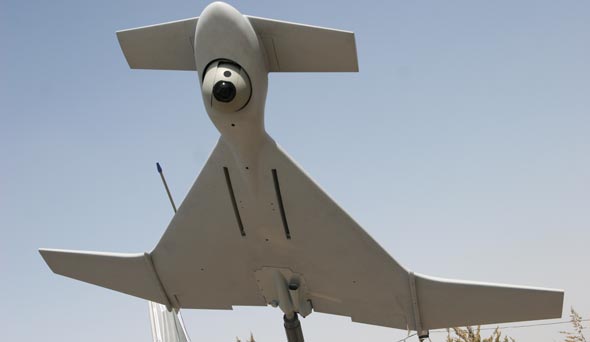Israel Aerospace Industries (IAI) is developing a loitering killer drone that has the capability to hunt illusive ground targets, such as anti-aircraft systems and mobile or concealed ballistic missile launchers. This expendable unmanned aerial vehicles, known as Harop, can be launched over a suspected area without specifically acquiring a specific target. Designed to reach targets at distances over 1,000km away, the UAV loiter over a suspected area for hours, spot target as they are exposed before activation and attack them immediately. IAI is already negotiating potential export sales of the weapon with India and Turkey. The company exposed the system for the first time in India, before the Aero-India 2009 airshow.

Harop resembles an earlier IAI’s ‘suicide drone’ known as Harpy. The main differences are the outer wing extensions, the longer nose and canard foreplane. Like Harpy, Harop is launched from a vehicle-mounted container. Harop augments the Harpy’s RF seeker with an electro-optical sensor, allowing it to acquire and pursue non emitting targets and moving targets, as well as ‘quit’ targets such as shut-down radars. As a loitering weapon, Harop can also be used against suspected ballistic missile sites, where target missile silos and shelters as they are opened before firing.
India is considering acquiring Harpy 2 (also known as ‘Harop’) killer drones developed by Israel Aerospace Industries, as part of a procurement program valued over $US1 billion. Harop is an evolution of the Harpy killer drone, optimized to operate against enemy radars and surface/air missiles. Harpy was developed in the 1990s and has been successfully exported to countries around the world.
Turkey is also interested in this Lethal Unmanned Aerial System capability and by the end of 2008 the Ministry of Defense was considering enhancing the Harpy radar killer drone capability with the loitering killer drone version of the system.
The Harop has evolved at IAI through a series of international cooperations that have never fully matured. In 1999 IAI discussed a joint prograp Raytheon known as the “Cutlass”, pursuing a ‘Combat Uninhabited Target Locate and Strike System’. Initially displayed in the Paris Air Show in 1999, the system combined the airframe of the Harpy UAV, made by Israel Aircraft Industries, with advanced sensors made by Raytheon Systems, which also manufactures the HARM (High Speed Anti-Radiation) missile. Cutlass was adapted for ship-based operations to support US Navy operations over land. It is designed for six hours missions, flying at speed of 100 knots and maximum range of 1,000 km. Unlike the autonomous Harpy, Cutlass also has a direct line-of-sight datalink capability at range up to 150 km. This range can be extended via relays built into each weapon.
In October 2005 Harop dubbed ‘White Hawk’, was presented to the UK Ministry of Defense, by a team lead by MBDA that also included IAI/MBT Division. Although MBDA was eventually selected as one of the finalists for the UK Loitering Munition Capability Demonstration (LMCD) program (which later evolved into the Fire Shadow), White Hawk was not selected for the program, as the MOD insisted on an ‘all British’ team.
















